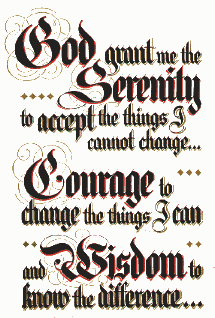My hope in telling you my story is that you see not only the devastation a traumatic brain injury can wreak, but also how a good life — although very different from what had been dreamed — is still attainable.
Bryan Durio
The Aspiring Lead Guitarist
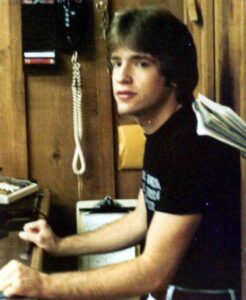
At 7 p.m. on Friday, November 2, 1979, after having put in a normal workday at my job as the Car Stereo Manager at New Generation (a small stereo shop in Lafayette, Louisiana), I was anxious to make my way to Sunset, a small town a few miles north, to practice with a promising rock band I had recently formed with three other guys. I was with the bass player and the singer/rhythm guitarist in a prior band, and we recruited a great drummer for this band. I played lead guitar in both bands.
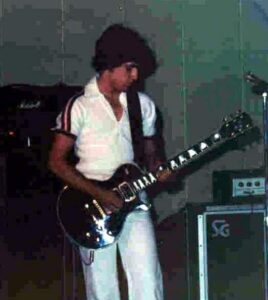
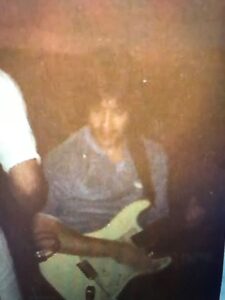

I gave a friend a ride to his house in Sunset and then went to practice, where we jammed for a few hours and then called it quits for the night. I don’t remember leaving practice but I’ve been told I argued up and down with the other guys about going out to do some drinking. I didn’t want to go because I was tired and had a heavy Saturday night planned with my girlfriend (Sunday was her birthday).
The next thing I remember is being almost home in Opelousas, a few miles north of Sunset. I was inside KSLO, the town’s radio station where I was an announcer, looking for a desktop mic stand to borrow. The station had been shut down since midnight, and I remember looking up at the clock in the AM studio and seeing that it was a little after 1 a.m. I recall marveling how different and spooky it was — so dark and quiet — with the studio lights off and only some lights softly glowing from the transmitter. That’s the very last I remember of that night. The next thing I was aware of was being in a dreamlike state almost five weeks later, trapped inside my head at Lafayette General Hospital.
The Mysterious Car Wreck
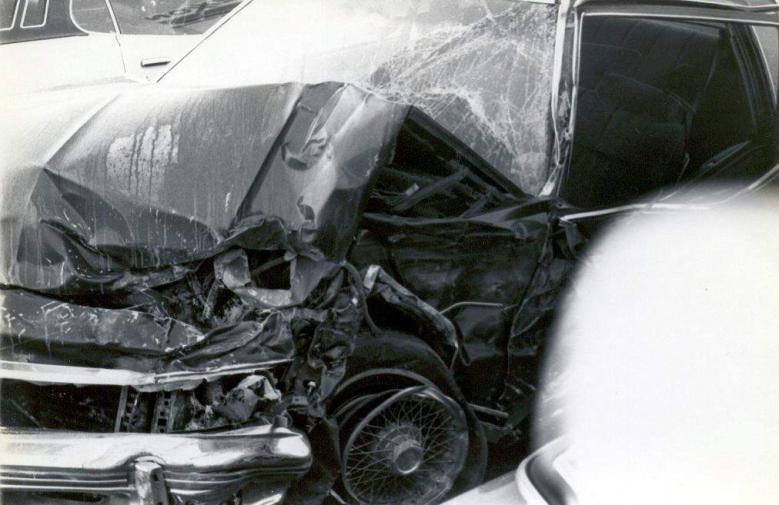
I’d left KSLO and was two miles from home when a drunk driver hit me head-on on a two-lane highway just north of town. No one heard the crash and no one called it in, but a State Trooper and a Parish Chaplain just happened to be driving down the road and discovered it sometime around 1:30 a.m. There was some confusion in trying to identify me and contact my parents — I had just renewed my driver’s license so all I had was a temporary DL card, and I was driving my assistant manager’s car. We’d traded cars for the weekend, so the registration didn’t match my license information. A couple of days later a columnist in the local newspaper reported that when I had been cut from the wreckage it was discovered that my heartbeat was lost, and that luckily, someone on the scene put his knowledge of CPR to good use. I was transported to Opelousas General Hospital where the team on duty swung into action, but I was in such bad shape no one thought I was going to make it. The E.R. physician, Dr. Thad Kretschmer, administered anti-swelling drugs (Mannitol, Solu-Cortef, Decadron) for my battered brain. I’ve been told by medical professionals that’s what saved my life.
OGH made a few phone calls and eventually reached my parents, and told them to come to the E.R. immediately. Almost as soon as they hung up, the hospital called back to say they were transferring me to Lafayette General Hospital, 25 miles down the highway. Dad, Mom, and my sister Anne rushed from Opelousas to Lafayette and arrived at LGH around 4 a.m. Neurosurgeon Dr. Ricardo Leoni had been called in and noted that I was comatose with decerebrate posturing (indicating severe brain damage) with contusions and hemorrhaging in my cerebrum and upper brain stem. When Dr. Leoni spoke with my family, though, he was upbeat and optimistic. He told them my brain stem was badly bruised and had two major blood clots, but that I had been given drugs to dissolve them and when they dissolved I would come out of the coma. He said I had youth on my side and that’s a big advantage. He also advised them that when I woke up I may not ever mentally reach a level above a five-year-old.
From that moment on, our lives would never be the same.
My mom and I had always been close, and she stayed with me almost the entire time I was in LGH, steadfastly determined to see me through my ordeal. She decided on that first day to write short summaries of my days in the hospital along with the names of a few of the many friends and family who came to the hospital, or called, to provide emotional support. Read her (almost) daily summaries as I progressed from being decerebrate and comatose to full consciousness during my six-week hospital stay. |
The Dream
I don’t remember much about my coma — mostly little snapshot memories from the last week or so of it — but I do remember that everything seemed like a dream. Fake and not making any sense. I didn’t know what had happened to me but I did figure out when whatever happened must have happened. I remembered being at work but I couldn’t remember anything after that. Hmmm . . . something must have happened to me at that point. But I had no idea how much time had passed since then. The main thing I felt was a lot of confusion and that I had absolutely no control over anything. I remember some strange left arm that I couldn’t feel was attached to my body, and I pointed to it and told one of the therapists, “This is not my arm. My arm works.” It was a nightmare, it was scary, and I didn’t like it at all.
Over the last couple of days of the coma, I became frustrated and despondent that I couldn’t wake up from my dream. I thought up a couple of ways to escape from my captors because I thought my family and the hospital staff were conspiring to keep me in the dream, so I figured I would have to break out of the hospital so I could wake up. A couple of days before I emerged I yelled at a statue of Jesus in the sun room at the end of the hall because he wouldn’t let me escape my torment. In my room I called out loudly for help a few times to anyone who could hear me — which I’m sure everyone within earshot appreciated!
The afternoon I emerged, it felt exactly like waking up from a deep sleep. My dad walked into my room with a big smile on his face and a cookie tin in his hand. He said, “Look what I brought you!” The card on the tin said, “These cookies baked especially for Bryan Durio by Mrs. Edna Kurtz.” When I read that, I thought, “Hey, I know Edna Kurtz!” She was the grandmother of one of my good friends from high school — but I was actually thinking of his mom. That was the moment I started having the sensation of rising up as if from a deep sleep and of my mind clearing up. Over the next couple of hours things slowly returned to normal. I couldn’t believe it. Was I back to reality? My bad dream was finally over.
The next morning I told Dad I wouldn’t wish a coma on my worst enemy. All these years later, I still wouldn’t.
Surprisingly enough, I had no broken bones from the car wreck — just a couple of deep cuts on my banged-up left shin, a black left eye, bruises, and a couple of cuts on the left side of my face. When I emerged from my coma on December 8th, five weeks to the day after the wreck, I had blurry double vision and was paralyzed with absolutely no feeling on my left side, like the numbness you have when you get a shot at the dentist’s office. Can you imagine what it’s like to try to get your fingers or toes to move and they refuse to? It still seemed like they weren’t mine at all because they wouldn’t cooperate!
I spent one more week in the hospital slowly coming to grips with my condition and spending a lot of time in physical and occupational therapy, working on getting even a little functionality back. When I was released on December 15th, six weeks to the day after the car wreck, I could barely walk and had to use a hemi walker or someone’s help to get around. I had no sense of balance. My speech was slow, slurred, and mushy. There were quite a few combinations of syllables I just could not manage to articulate. My short-term memory was so bad I couldn’t remember what I had eaten just minutes after a meal. My left hand was clenched and my left arm was so weak I couldn’t even grasp a quarter-pound dumbbell or press it toward the ceiling while lying on my back.
So What The Heck Do I Do Now?
I found myself physically unable to do a lot of things I had considered routine. I couldn’t believe how my “new normal” was so different and how much of an uphill battle lay ahead of me. I had to figure out how to take a shower, dress myself, tie my shoes, eat, and do literally anything and everything else in my daily living using only my right hand. (When getting dressed or undressed, always go with the affected side first.) I discovered that I could cut just about any food only using a fork. I also had to learn how to swallow liquids without them going down the wrong pipe — usually prompting an extended round of coughing — but to this day I haven’t completely mastered that simple act.
I received an overwhelming number of gifts that Christmas, including a great game called Simon (online version here) that I wore out trying to improve my memory. My physical therapist in Opelousas challenged me to wean myself from the walker after a few weeks and I somehow managed to do it, but I still had a very bad limp and my left arm was abnormally postured. I had to wear a plastic splint on my lower left leg because my foot kept dropping when I walked. I also frequently wore a plastic splint on my left arm and hand to try to counter the hand’s tendency to clench up. To work on my speech I practiced tongue twisters (using A Twister of Twists, a Tangler of Tongues: Tongue Twisters).
A huge problem was that my entire left side was numb — it still is, for the most part, and I don’t expect my sensory perception to ever return to anything near normal on that side. Sensations in my arm and hand are dulled, like I have a sweater and a glove on all the time. Because of the numbness and brain damage, my sense of balance took a major hit (pun intended) and is not good at all to this day. I have a hard time walking in the dark or in dim light, and sometimes even in broad daylight. Talk about a setback! I was deeply depressed because I could no longer play the guitar, which had pretty much become my driving ambition up to the car wreck (again, pun intended). In fact, I couldn’t even hold up the neck of my guitar with my left hand much less play it, but for the next few years I kept trying and trying to play even the simplest of chords (I called them “baby chords”) with little success. Although I didn’t think I was all that good, I had developed a reputation as a badass, hot guitar player, but now all I could do was reminisce about it. What helped more than a little bit was spending hours sitting in my car at home, listening to cassettes of songs I used to play and albums I liked. My music was comfort when nothing else was.
I tried to get something going again at KSLO and later at KSMB in Lafayette, but my voice and diction were now very unreliable and although I had always been an excellent reader, I found I could no longer read “cold” — meaning that I couldn’t just take something and read it aloud without scanning it first. I had to pre-read it several times before attempting it and even then I usually had a very hard time with it. To this day reading aloud is usually difficult for me. Often words come out of my mouth that aren’t even on the page! I also found I forgot things. I forgot to tape news feeds coming down from the wire service. I forgot which song I was playing. I forgot the song I was going to play coming out of a block of spots (commercials). I forgot which songs I’d just played. I forgot to take meter readings. I forgot. A lot.
I’ve always loved Gerry Rafferty’s signature song, 1978’s “Baker Street,” but a few lines from it now haunted me:
You used to think that it was so easy
You used to say that it was so easy
But you’re tryin’, you’re tryin’ now
Another year and then you’d be happy
Just one more year and then you’d be happy
But you’re cryin’, you’re cryin’ now
I felt like Gerry was singing about me. I was tryin’. And I was cryin’. I wanted my life back the way it used to be! Back home I also found that, whereas lots of my friends and family had gone to the hospital to check on me and give support, hardly anyone came to visit me now. To make matters worse, I’d lost my independence and had to rely on others for transportation. In a way I felt abandoned — it seemed like for the most part, I had become an inconvenience because Mom and Dad’s house was out in the country and my friends didn’t want to drive all the way out there. My girlfriend broke up with me after a few months. Not everything was bad, of course, but things just weren’t working out with my “new normal.”
College, Here I Come (Again)!
After spending the first half of 1980 doing little more than physical therapy I was about to go stir-crazy from frustration, boredom, and social isolation, and I knew something had to change. So I decided to re-enroll in Computer Science at the University of Southwestern Louisiana for the summer 1980 semester. (I had dropped out of USL in April, 1979, because I was much more interested in playing guitar.) After all, I figured, my mind was still intact and functional, and with my left side being so uncooperative I sure wasn’t going to be doing any physical labor anytime soon. And as it turned out, that one decision was the single best thing I could have done to get my life back on track! My fortunes were about to change dramatically.
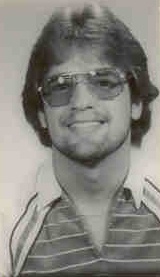
On campus, I quickly found that having a wry sense of humor and making people laugh was reassuring and a way to feel accepted, and it also helped me cope with my deficits. Constantly being around so many people helped my speech get better and also helped my personality return to something resembling what it was before the wreck. I had to force myself to use my left hand as much as possible but I learned to type mainly with my right hand, with my left hand merely helping every now and then because I couldn’t move its fingers much or feel the keys. My short-term memory was so badly affected, studying was a huge challenge — I would usually have to re-read paragraphs two or three times because I would get to the end of one and realize nothing had sunken in and I couldn’t remember what I’d just read.
I was very self-conscious walking around campus because of my limp and my left arm and hand looking funny, and people would glance, or worse, stare at me with this certain look because I had an odd gait and was a little spastic. So I decided to ride a bicycle virtually everywhere around campus to help retrain my left leg to have a normal walking rhythm. I did all kinds of things in PT/OT, including riding a stationary bike, playing jacks with only my left hand, screwing and unscrewing nuts and bolts with my left hand, shuffling and dealing playing cards, and trying to find coins in a Tupperware bowl of uncooked rice with — you guessed it — my left hand (I didn’t care for that one because it only felt like pins and needles). Outside of therapy, I continuously worked on appearing like nothing was wrong with me and by 1982 was pretty good at it.
Through my first couple of years in college I came to the realization I was good at explaining things and mentoring people, so in 1982 I volunteered as a Terminal Room Consultant in the Computer Center, helping to resolve user issues and problems in virtually all aspects of using the campus computer, a Honeywell Multics mainframe. That was challenging and a lot of fun, being able to quickly figure out a solution to a user problem. I also got a lot of practice typing solely with my right hand when leaning into a cubicle to help fix a user’s SNAFU. In the summers of 1982 and 1983 I got my first taste of the corporate world by working as a Conversion Specialist (a fancy title for an apprentice programmer) for Honeywell Information Systems in Atlanta, and I was released from PT back in Lafayette.

Back to “Baker Street.” I kept telling people, “Give me one more year and I’ll be able to play the guitar again.” Just one more year and then I’d be happy. Again and again, just one more year. But I eventually had to face reality. Because my guitar-playing ability never came back (it’s hard to play when you can’t feel the strings and you can’t form chords anyway), I sold my guitar and amp in the fall of 1984. I then turned my skill at playing guitar into honing my ability to do serious listening to well-recorded music, listening for and savoring all the details and nuances in songs.
Taking On the Corporate World, Sorta
Upon graduation from USL in December, 1984, I embarked on what I’d hoped would be a long programming and training career, working as a regular employee and a consultant/contractor for a few companies in the DC area (teaching Multics systems programming at Honeywell Federal Systems Division was the first); Huntsville, Alabama; and Atlanta, Georgia. In the late 90s I slowly came to the conclusion that programming had been a lot more fun at USL than it was in industry, and I really wanted to get back to my passion, music. I thought about getting back into radio, but radio had changed too much from what it was like back in the day, so I began DJing parties and wedding receptions. I started getting so many DJ inquiries, I finally abandoned the programming world in 2000 and went full-time with my single-op small business, Rock Around the Clock DJ Services. Since I’ve always been pretty good with the English language, I started a one-man proofreading/editing/website development business, Dr. Proof, in 2006. I recently worked as a Quality Specialist/Website Proofer at an online marketing solutions company, and am a freelance proofreader/editor working on various projects using my strengths, abilities, and interests.
The Next Chapter
In early 2009, my wife, Laura — we met back in 1983 at USL and were married in 1987 — encouraged me to volunteer at Shepherd Center to help other people with brain injuries. When I inquired, the volunteer coordinator at Shepherd referred me to Ann Boriskie, who had an organization called the Brain Injury Peer Visitor Program. It sounded like a perfect fit for what I wanted to do. In the time I’ve been a Peer Visitor I’ve learned a lot more about brain injuries, and I think I have finally figured out what I’m supposed to do with my life. It’s very gratifying to counsel, encourage, and inspire other people with brain injuries and their caregivers — and I strive to be a role model, showing other brain injury survivors that there’s light at the end of the tunnel and the sky’s the limit as to the extent of their recovery, but they have to work at it.
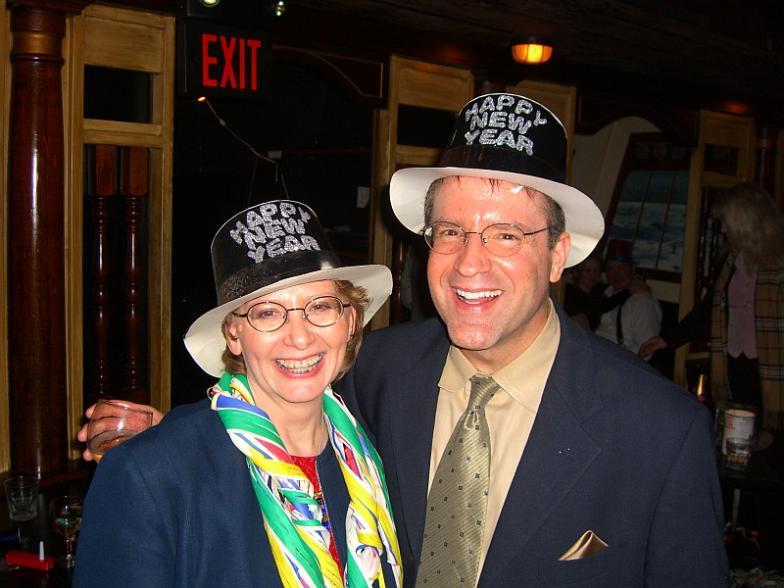
Now my short-term memory and instant recall are not the best in the world, but I find that writing things down helps a lot. In fact, I would be lost without Microsoft Outlook’s Calendar! I still have problems with my balance and coordination, and as mentioned, I have dulled tactile sensation and almost no spatial awareness on my left side. You’ve probably noticed that the numbness is a recurring theme here. That’s because the old saying is true: You don’t know what you’ve got ’til it’s gone. Our sense of touch is so very important in our everyday living. But over the years I’ve learned to cope and have become pretty good at masking my deficits, so no one’s the wiser. In fact, I like to tell people that I’m a master in the ancient art of Foo Ling!
What I’ve learned in the past 40 years is, if we take the time and make the effort — staying open-minded and realistic, of course — we can achieve more than we thought we could, despite the obstacles in our way.
